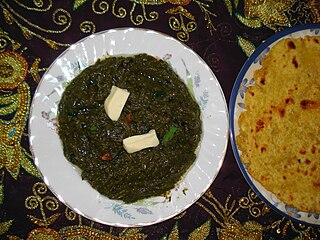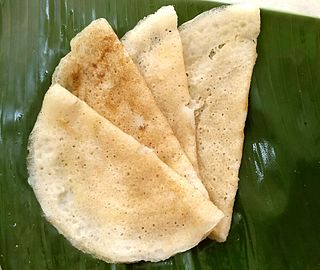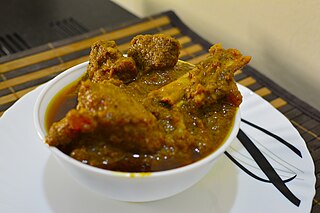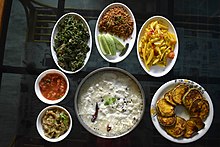
Ethiopian cuisine characteristically consists of vegetable and often very spicy meat dishes. This is usually in the form of wat, a thick stew, served on top of injera, a large sourdough flatbread, which is about 50 centimeters in diameter and made out of fermented teff flour. Ethiopians usually eat with their right hands, using pieces of injera to pick up bites of entrées and side dishes.
Indian cuisine consists of a variety of regional and traditional cuisines native to the Indian subcontinent. Given the diversity in soil, climate, culture, ethnic groups, and occupations, these cuisines vary substantially and use locally available spices, herbs, vegetables, and fruits.

Jaggery is a traditional non-centrifugal cane sugar consumed in the Indian subcontinent, Southeast Asia, Central America, Pakistan, Brazil and Africa. It is a concentrated product of cane juice and often date or palm sap without separation of the molasses and crystals, and can vary from golden brown to dark brown in colour. It contains up to 50% sucrose, up to 20% invert sugars, and up to 20% moisture, with the remainder made up of other insoluble matter, such as wood ash, proteins, and bagasse fibres. Jaggery is very similar to muscovado, an important sweetener in Portuguese, British and French cuisine. The Kenyan Sukari ngutu/nguru has no fibre; it is dark and is made from sugarcane and also sometimes extracted from palm tree.

Saag, also spelled sag or saga, is an Indian subcontinental leafy vegetable dish eaten with bread such as roti or naan, or in some regions with rice. Saag can be made from spinach, mustard greens, collard greens, basella, finely chopped broccoli or other greens, along with added spices and sometimes other ingredients such as chhena.

Sri Lankan cuisine is known for its particular combinations of herbs, spices, fish, vegetables, rices, and fruits. The cuisine is highly centered around many varieties of rice, as well as coconut which is a ubiquitous plant throughout the country. Seafood also plays a significant role in the cuisine, be it fresh fish or preserved fish. As a country that was a hub in the historic oceanic silk road, contact with foreign traders brought new food items and cultural influences in addition to the local traditions of the country's ethnic groups, all of which have helped shape Sri Lankan cuisine. Influences from Indian, Indonesian and Dutch cuisines are most evident with Sri Lankan cuisine sharing close ties to other neighbouring South and Southeast Asian cuisines.

Assamese cuisine is the cuisine of the Indian state of Assam. It is a style of cooking that is a confluence of cooking habits of the hills that favour fermentation and drying as forms of preservation and those from the plains that provide extremely wide variety of fresh vegetables and greens, and an abundance of fish and meat. Both are centred on the main ingredient — rice. It is a mixture of different indigenous styles with considerable regional variations and some external influences. The traditional way of cooking and the cuisine of Assam is very similar to South-East Asian countries such as Thailand, Burma (Myanmar) and others. The cuisine is characterized by very little use of spices, little cooking over fire, and strong flavours due mainly to the use of endemic exotic fruits and vegetables that are either fresh, dried or fermented. Fish is widely used, and birds like duck, pigeon, squab, etc. are very popular, which are often paired with a main vegetable or ingredient; beef used to be eaten before British colonialism, and some continue to do so. Preparations are rarely elaborate. The practice of bhuna, the gentle frying of spices before the addition of the main ingredients so common in Indian cooking, is absent in the cuisine of Assam. The preferred oil for cooking is the pungent mustard oil.

South Asian cuisine, includes the traditional cuisines from the modern-day South Asian republics of Bangladesh, India, Maldives, Nepal, Pakistan and Sri Lanka, also sometimes including the kingdom of Bhutan and the emirate of Afghanistan. Also sometimes known as Desi cuisine, it has been influenced by and also has influenced other Asian cuisines beyond the Indian subcontinent.
Maharashtrian or Marathicuisine is the cuisine of the Marathi people from the Indian state of Maharashtra. It has distinctive attributes, while sharing much with other Indian cuisines. Traditionally, Maharashtrians have considered their food to be more austere than others.

Pakhaḷa is an Odia cuisine, consisting of cooked rice washed or lightly fermented in water. The liquid part of the dish is known as Toraṇi. It is popular in the state of Odisha and its similar in the eastern regions like Jharkhand the northeastern states of Assam.
Goan cuisine consists of regional foods popular in Goa, an Indian state located along India's west coast on the shore of the Arabian Sea. Rice, seafood, coconut, vegetables, meat, bread, pork and local spices are some of the main ingredients in Goan cuisine. Use of kokum and vinegar is another distinct feature. Goan food is considered incomplete without fish.

Jharkhandi cuisine is the cuisine of the Indian state of Jharkhand. Staple foods are rice, dal and vegetables. Common meals often consist of vegetables that are cooked in various ways, such as curried, fried, roasted and boiled. Many traditional dishes of Jharkhand may not be available at restaurants.

Ghugni or ghuguni or guguni is a curry made of peas or chickpeas. Different variations of the dish use different types of peas or chickpeas, such as black gram, green peas, or white peas. It is a snack native to the Indian subcontinent, especially popular in Eastern India, Northeast India and in Bangladesh.
Dahi machha is a traditional Odia delicacy made of fish in a spicy yogurt based sauce. It is eaten usually served with rice as an accompaniment. Dahi Machha Jhola is liberally seasoned with turmeric, onions, garlic, mustard and garam masala. The use of turmeric imparts a yellow colour to the sauce base. Before being served, chopped fresh cilantro may be sprinkled on top for added flavour as well as enhanced appearance.

Chakuli pitha is a flat Odia rice-based fermented cake traditionally popular in the regions of Odisha state in India. It is prepared and served during festivals.

Chandrakanti is a deep-fried dessert made from green gram and rice flour. It is a sweet dish originally from coastal Odisha in eastern India.

Malaysian Indian cuisine, or the cooking of the ethnic Indian communities in Malaysia, consists of adaptations of authentic dishes from India, as well as original creations inspired by the diverse food culture of Malaysia. Because the vast majority of Malaysia's Indian community are of South Indian descent, and are mostly ethnic Tamils who are descendants of immigrants from a historical region which consists of the modern Indian state of Tamil Nadu and Sri Lanka's Northern Province, much of Malaysian Indian cuisine is predominantly South Indian inspired in character and taste. A typical Malaysian Indian dish is likely to be redolent with curry leaves, whole and powdered spice, and contains fresh coconut in various forms. Ghee is still widely used for cooking, although vegetable oils and refined palm oils are now commonplace in home kitchens. Before a meal it is customary to wash hands as cutlery is often not used while eating, with the exception of a serving spoon for each respective dish.
Ogi is a village located in Angul district, in the Indian state of Odisha. The Village Ogi which is often called Ogi-Para because of its close proximity to Para village is well known from the British colonial era. Notable People including Pabitra Mohan Pradhan, Sarangadhar Das, and Mahatma Gandhi had also visited to the Ogi village in its history.
Sisua is a medium-sized village in the Salipur taluk/mandal/tehsil/block of Cuttack district in the state of Odisha, India, close to the new Sisua Village Jagannath Temple. The village lies South of Cuttack to Kendraparda road left of Sisua village road if traveling South. As of 2009 Kantapara is the gram panchayat of Sisua village

Mutton curry is a dish that is prepared from goat meat and vegetables. The dish is found in different variations across all states, countries and regions of the Indian subcontinent and the Caribbean.




























